IN THIS GUIDE:
- Getting There
- Hotels
- Guided Tours
- Day 1
- Day 2
- Day 3
- …and more
Years ago, I stood with my back to Rome’s renowned Trevi Fountain, coin in my right hand and filled with nervous excitement. It was my first trip to Europe. I was young, naïve and packed elbow-to-elbow with my tour mates as we all scrambled to capture that iconic photo and ensure our return journey to the Eternal City. I can’t say for certain that it is the fountain’s magic that has since brought me back, but I do know that Rome filled me with a sense of awe at the grandiosity of time and a need for constant exploration and discovery. Rome is chaotic, overwhelming and impossible to soak up in three days, but that’s the beauty of it. You will need to go back, again… and again.
So, let’s get started on our adventure. The 3-day Rome itinerary suggested below assumes you land in the morning and need to adjust to your new time zone quickly. However, if you arrive later in the afternoon or evening, simply explore your new neighborhood, find a quaint local taverna or osteria and begin with Day 2 the following morning and return to our outlined Day 1 for your last day.
Getting To Rome
Before we start exploring this remarkable city, let’s talk briefly about how to get there and where to stay. Since its inception as a small town in beginning in the eighth century B.C, Rome has expanded into a bustling metropolis with numerous transportation and accommodation options. If you’re flying in from the states, major carriers like American, Delta and United fly direct from cities like New York, Boston, Philadelphia, Chicago, and Miami. It’s best to track flight deals from your home airport as they arise and book as soon as possible. At the time of this writing, prices have been going up. Short-haul flights are also easy to find directly into Rome if you’re already in Europe. You can also book private airport-to-hotel transfers.
Alternatively, you can take a train from many mainland major European cities.
Recommended Hotels
When it comes to accommodation in Rome, here at Winetraveler we like to think about upscale properties in ideal locations. For instance, we recently stayed at the opulent 5-star Palazzo Manfredi and woke up to stunning views of the Colosseum right outside our window.
Another great upscale option in Central Rome within 15 minutes of many of the major sites and landmarks is the Dharma Boutique Hotel & SPA.
If you’re a foodie like we are, and are looking to experience the lively bohemian side of the city, stay in the Trastevere neighborhood at the Donna Camilla Savelli. Regardless of which hotel you choose, Rome is a very walkable city, just keep in mind that the summer months are very warm indeed.
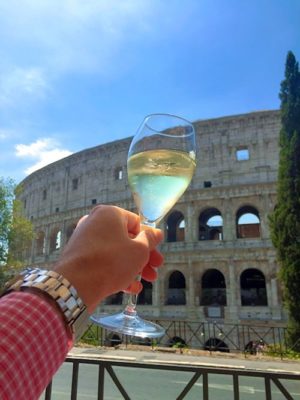
Guided Experiences, Tours & Skip-the-line Tickets
If it’s your first time in Rome, don’t know where to start or you prefer a guided experience, we have a number of recommendations for various travel styles. There really is so much to do in this city, so you can make the most of your time if you use an experienced guide and/or prebook tickets to many of the major landmarks. Each of the experiences we suggest below our readers have sampled, and all are highly rated.
Save time and stress by booking your ticket to see the Vatican Museums and Sistine Chapel ahead of time.
Experience some of the most famous sites in Rome by securing your ticket early to into the Colosseum, Palatine Hill, and the Roman Forum. This special ticket gives you fast-track entrance to all 3. Once inside each location, explore at your own pace.
If you’d like to have an expert local guide drive you around in a luxury, air-conditioned vehicle to experience most of Rome in just one day, consider scheduling a day tour of the city with our friends at RGV. Our readers have all raved about their experience, and seeing most of the city in one day will allow you to spend the other 2 days on this itinerary exploring Rome at your own pace.
Another fun way to experience Rome if you don’t feel like doing a ton of walking is to see it by Private Golf Cart! Our friends at Rolling Rome will give you an immersive tour of many of the city’s famous sites in a comfortable, covered golf cart. This option is great during the summer months and is also perfect for families.
Day 1
Welcome to Rome! It’s a busy city with 2.7 million residents and you’re likely running on adrenaline or already experiencing the exhaustion from the overnight flight. Either way, fresh air and sunshine will help to reset your internal clock and get you started on the right foot. Store your luggage at your hotel, or rental if possible (alternatively, the airport and train stations also have storage options), then grab a sandwich or fruit at a nearby market and make your way outside of the city to the Appia Antica Regional Park.
All Roads Lead to Rome
The 8,650-acre park, closed to traffic on Sundays, is filled with paths for biking and walking. The most famous of the paths and the primary reason for visiting is the Via Appia Antica, believed to be the oldest road in Rome, built in 312 B.C. Either rent a bike or take a leisurely stroll along the quiet, scenic and ancient road, perfect for an afternoon picnic. It’s a wonderfully contradictory way to begin your Roman adventure, away from the bustle of the city and on the very roads once traversed by Julius Caesar, Augustus, Cicero, Mark Antony and millions of others. The enormity of it is almost tangible.
After an afternoon in the park, collect your luggage, check into your hotel or apartment and freshen up for the evening ahead. Being Winetravelers, it’s now time for glass of Italian wine and a snack before heading to the Colosseum. Make sure to check ahead on the closing time of the Colosseum for your season of travel as you’ll want to arrive an hour and a half to two hours prior to close. As for that all-important glass of wine, here are a few options near the Colosseum we recommend:
Enoteca Wineconcept – an upscale wine bar featuring wines by the glass or bottle and gourmet small plates, the boutique features an impressive 4,000 bottles of wine and several natural wine options.
Al Vino Al Vino – an unpretentious, intimate neighborhood wine bar in the heart of Monti. The unassuming bar offers daily selections by the glass, small plates, a wide selection of wines by the bottle and amazingly, often has seats available.
Divin Ostilia – a cozy eatery with pizzas, pastas and an incredible wine list at very reasonable prices. Limited seating, but we found it worth the wait.
RELATED: A Wine Lover’s Guide To Exploring Central Italy
A Colossal Adventure
On arrival at the Colosseum head immediately to the queue for tickets. Or, as we mentioned earlier, get your tickets online ahead of time. The lines are dramatically shorter in the hours before closing and the crowds inside are fewer as well.
As the sun moves toward the horizon, explore the ins and outs of this renowned, brutal and incredible amphitheater. Constructed in 72 A.D., the architectural detail is remarkable and the history overwhelming. Known at the time as the Flavian Amphitheater the Colosseum remains the largest amphitheater ever constructed. It was opened in 80 A.D. by Emperor Vespasian’s son Titus for gladiatorial combats and wild animal fights and it remained active for four centuries.
As the crowds dwindle, you’ll be able to move freely throughout catching the shadows cast by the setting sun. Each vantage point offers impressive and thought-provoking perspectives, and it’s the perfect way to end your first full day in Rome.
Finally, as you return to your hotel for a much-needed night’s rest, walk past The Forum and up Capitoline Hill as the lights come on and the skies darken. The view of the Forum from atop the hill is a must-see, especially at night. The ruins are eerily empty and quiet, and standing above what was once the very center of civilization is nothing short of awe-inspiring.

Day 2
Now that you’ve adjusted to the local time zone, you’re ready for a full day in the Eternal City and it begins in Vatican City. The museums, Sistine Chapel and St. Peter’s Basilica open at 9 a.m. and it’s best to arrive early. How you see the sights is really a matter of time and personal preference. You can opt to take a two-hour guided tour which requires a reservation and includes the most renowned sights, the Sistine Chapel and St. Peter’s. For a guided tour, purchase your tickets in advance. A guided tour reduces wait times both for the museums and St. Peter’s (for which self-guided guests must wait in a separate entry line to enter).
RELATED: How To Explore Venice Italy In One Day
Should you opt for a self-guided tour, you can still purchase your tickets online (with an option for a “skip the line” upgrade) or on-site. A self-guided tour gives you the option of seeing the sights that are of most interest to you, in addition to doing so at your own speed. You can either zip through (as much as the crowds will allow) or take your time and immerse in the surrounding Renaissance frescoes and detailed sculptures.
The Sistine Chapel marks the end of the tour. You will be briskly (and often brusquely) moved through the chapel where the no photography rule is strictly enforced at which point if you want to visit St. Peter’s Basilica you will need to exit, queue for the Basilica again outside, and pass through security once more. That said, there is a well-known hack to slip through to St. Peter’s via a tour group-only shortcut. Google it.
Fun Winetraveler Fact: Vatican City has the highest per capita wine consumption in the world with residents consuming an average of 74 liters of wine annually, or twice the per capita consumption in the rest of Italy and seven times the per capita consumption in the United States!
Pizza, Pasta and Piazzas!
Now that you’ve marveled in all the Vatican’s glory, it’s time to return to the chaos, noise, bustle and fun of Rome. It’s a remarkably walkable city, just use caution crossing the constantly busy streets (unless it’s August and most Romans are on holiday). Vatican City is across the Tiber River from central Rome, so cross back over and pick your direction. You can head northeast toward the Piazza del Popolo for lunch, the Borghese Gallery for more art, or the Borghese Gardens for a stroll through the lushly landscaped park.
Or if you’re ready to simply slow down, meander from one piazza to the next, drinking wine and observing Roman life, follow our suggestions due east toward the Piazza Navona.
Piazza Navona is a picturesque Roman piazza surrounded by colorful Baroque architecture and featuring three delightful fountains: the Fontana dei Quattro Fiumi, the Fontana del Moro and the Fontana del Nettuno. Street artists, tourists, peddlers and perhaps even a few locals fill the piazza and the cafes lining the perimeter are perfect for grabbing a glass of wine and people watching.
However, if after sitting fountain-side and wandering the piazza, you’re ready for both food and drink, we recommend visiting either Tre Scalini or our favorite, Enoteca Il Goccetto. Tre Scalini is a an upscale, yet comfortable restaurant and café in the heart of Piazza Navona. It’s also arguably one of the more well-known destinations for tourists, so be prepared for crowds.
Enoteca Il Goccetto by contrast is an intimate and ancient enoteca with a wooden ceiling, medieval chandeliers and over 800 labels of Italian and French wines. Dine inside with small plates and a glass of wine or take your glass to the steps outside for people watching. Either way, you can’t go wrong.
RELATED: There’s a Free Wine Fountain in Italy That’s Now Open to the Public
Heading further south from Piazza Navona, you’ll come to Campo de’ Fiori. This square is delightfully more for the locals; although still often visited by tourists. It’s home to one of Rome’s most well-known markets, numerous bars and eateries. If you only snacked in Piazza Navona, we recommend lunch at either Ditirambo or heading toward the Palazzo Farnese to Hostaria Farnese.
Ditirambo is a traditional trattoria serving Roman classics and offering an extensive wine list. Hostaria Farnese is quieter and more intimate with outdoor seating in the warmer months. Closed on Thursdays, it’s a delightful experience for lunch with a decent wine menu. Or if you would prefer another light snack and wine, head past Campo de’ Fiori to L’Angolo Divino for a refreshing small plate and glass of wine.
Step Back in Time in Trastevere
As the afternoon progresses, it’s time to walk off some of the snacks and wine and head toward the eclectic, bohemian area of Rome across the Tiber River, Trastevere. A medieval, working-class neighborhood and artist community, Trastevere is known for its food and beer, artisan shops and authentically Roman atmosphere.
Arriving in the evening you can join the pre-dinner passeggiata (evening promenade like Spain’s paseo), which culminates around the Piazza de Santa Maria. The vibe is young, hip and energetic. Pop in for dinner at any of the neighborhood trattorias, savor a craft beer, or more Italian wine and while away the hours without a care in the world. Of course, we have a few suggestions, but it’s hard to go wrong in Trastevere:
Trattoria de Gli Amici – is situated on a cheerful piazza and is staffed by both volunteers and people with disabilities welcoming guests and serving fresh Italian classics.
Giggetto al Portico d’ Ottavia – located in the former Jewish ghetto, this eatery is known for its Jewish-Roman cuisine including fried artichokes and squash flowers. Make sure to check out the wine cellar built from the foundations of the ancient Roman Portico d’Ottavia.
Cajo e Gajo – in the Piazza San Calisto, Cajo e Gajo offers homemade pastas and traditional Roman dishes with outdoor seating in the Piazza.
Enoteca Trastavere – a full-service restaurant with outdoor seating and an extensive wine list and a selection of cocktails.
Vin Allegro – extensive wine list, happy hour specials and all from an ivy-clad wine bar and candlelit tables along the exposed stone walls.
In Vino Veritas – fun atmosphere for a glass of wine on your way to dinner.
Freni e Frizioni – a popular early evening spot with a renowned buffet and outdoor terrace, this popular spot fills up quickly.
If you’re not too exhausted from the busy day, Trastevere comes even more alive at nightfall. Shutters are raised and doors opened to reveal a plethora of enotecas and taverns. Wander the narrow streets and visit the small squares, you won’t lack options, and get a taste of the authentic Roman essence. Alternatively, return to the Campo de’ Fiori and join the Romans spilling into the square with wine and beer from the many taverns and eateries.
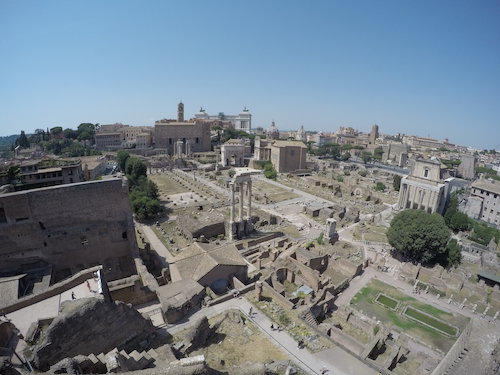
Day 3
For day three in Rome, we recommend more exploration of the sights and savoring la dolce vita. Begin your day with a tour of the Roman Forum, first used as an Etruscan burial ground in the 7th century B.C. and then the social, political and commercial center for the Roman Empire.
If you have the time, an inside tour of the grounds will impress, but if you prefer to hit the pavement and see as much of Rome as possible, return to Capitoline Hill for a top-down view of the Forum. Notice the drastic contrast from your previous nighttime visit before setting off toward Piazza Venezia, the Colonna Traiana and the Mercati di Traiano.
As you head toward the Mercati di Traiano, a mass complex of ruins and Imperial museums, you’ll see the very center of Rome, the Piazza Venezia. Located at the intersection of the Via dei Fiori Imperiali and the Via del Corso, Piazza Venezia is a sunny square featuring the monument of King Vittorio Emmanuele II.
Next you’ll pass the Colonna Traiano, or Trajan’s Column, commemorating the Roman Emperor Trajan’s victory in the Dacian War. Completed in 113 A.D. the impressive column features 155 scenes depicting the emperor’s victory all carved in a spiral frieze.
The last stop before lunch is the Mercati di Traiano, or Trajan’s Market. This complex series of ancient ruins is also home to the Imperial Forum Museum. Featuring red brick and concrete the Market once had six levels and up to 150 different shops and apartments. A visit to the museum will allow you to visit various levels of the market and exhibits offering a look at classical Rome.
RELATED: The Perfect Itinerary For Exploring Italy’s Cinque Terre
Next, we recommend a stop at a local wine bar, Il Vinaietto. The no-frills historic wine bar offers a wide selection of delicious Italian wine and is a fabulous place to huddle outside with a glass. Although they don’t offer food, you can bring your own from a nearby bakery, pizzeria or deli.
After a good session of people watching, drinking wine and savoring the Italian lifestyle, it’s time to visit the Largo di Torre Argentina, an open-air square dating back to the 3rd century B.C. and 4th century A.D. The square features four temples and the base of the former Curia Pompeia.
Worth Noting: The Curia was located at the entrance of the Theater of Pompey where Julius Caesar was assassinated by Roman senators.
If you prefer to settle in for lunch, we recommend a stop at Casa Bleve, an upscale wine bar and restaurant in the courtyard of a 16th century palazzo. The area, once known for noblemen’s houses is halfway between the Pantheon and Piazza Navona, and you can view the remains of an ancient Roman wall in the cellars of the restaurant. Although on the pricey end, the food is delectable and the wines impressive. Make sure to stop at the Pantheon on your way. It’s one of the most replicated architectural designs in history, featuring a portico with free-standing columns and a domed rotunda. The origins and purpose of the Pantheon are debatable, but the profound influence of its architecture is not.
As evening settles in, make your way to the Spanish Steps and Via Condotti. Via Condotti is a fashionable street and pedestrian thoroughfare. Each evening tourists and Romans alike fill the streets for passeggiata. It is an energetic, lively atmosphere that is a must on your first trip to Rome. Via Condotti begins at the base of the Spanish Steps, which is also a must-see. Since the time of their construction in the 1700s, the 135 Spanish Steps have attracted artists, poets, and writers and serve as a public gathering place. Plan to begin or end your time here, just grab a seat, observe and absorb.
As for dinner, walk through the neighborhood and find something to your tastes. While we can make recommendations, we certainly haven’t explored all the options and recommend you make your own discovery. That said, we do recommend you stop in Antico Caffè Greco, the oldest coffee bar in Rome once frequented by Casanova, Goethe, Lord Byron and Keats. If you’d like a table at the Caffe it’s best to reserve it in advance.
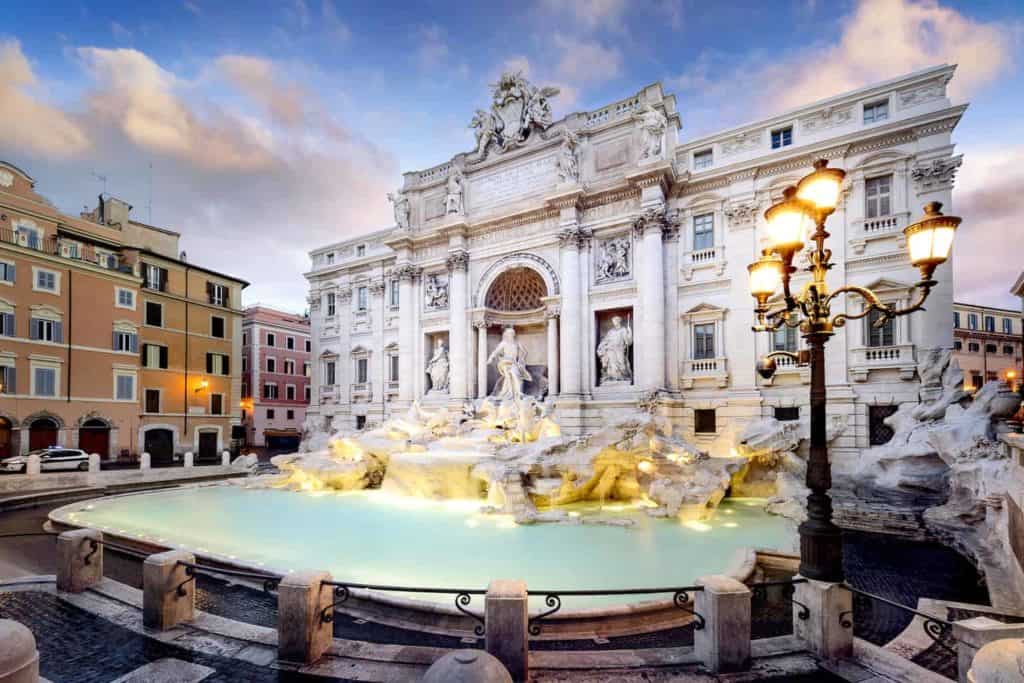
Finally, after dining, strolling and sipping amongst Rome’s fashionable and designer crowd, it’s time to visit the Trevi Fountain. While it is one of the utmost touristy things to do in this fascinating city, it’s one I return to every time I visit, if for nothing other than the assurance of a return trip!
The visually arresting Baroque-style fountain is simply stunning as darkness sets in and the lights illuminate the flowing water and stone façade. Take a few moments before pushing your way through the crowd toward the fountain to reflect on the vast amount of sights and steps, and the grandiosity of history, you have covered in three short days. Then grab your coin, push your way through to the front of the fountain, hold the coin in your right hand with your back to the fountain and toss it in over your left shoulder. You are now ensured a return trip to this eternal city.
RELATED: How To Get Cheaper Flight Tickets: 11 Proven Methods
When in Rome
Rome is a romantic, brutal and chaotic city with a complicated history, deep soul and enticing atmosphere. You certainly can’t see it all in three days, but the sights, sounds and energy of this exciting city will stay with you for eternity. And honestly, where better to taste wine than the very birthplace of the civilization that had one of the greatest impacts on viticulture and enology?
More Italian Travel Guides and Travel Inspiration
Discover Central Italy: A Wine & Food Lover’s Travel Guide
Chianti Itinerary: How To Spend 5 Days in Italy’s Chianti Region
San Marino 2 Day Itinerary: Complete Travel Guide
Here’s Why You Should Visit Ischia Italy: Europe’s Best-Kept Island Secret
Cinque Terre Italy Itinerary: Travel Guide For Wine Lovers
You are reading “How To Spend 3 Days in Rome: Itinerary for Food, Wine & History Buffs” Back To Top
things to do in Italy, best things to do in Rome in 3 days: best places to visit in Italy
If you enjoyed this guide, consider joining the Facebook Group to interact with other Winetravelers and for travel inspiration around the world, and be sure to follow along with us on Instagram.

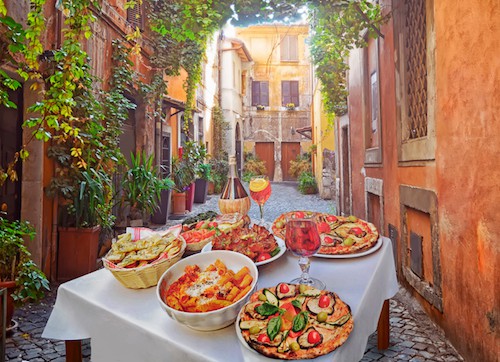
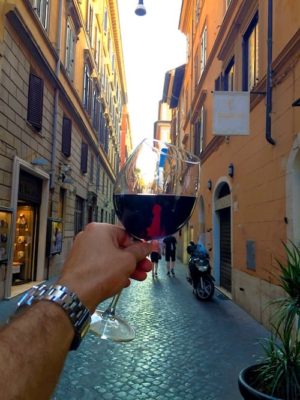
Rome is very beautiful place which I visited in 2015. What I liked was walking on the streets in the evening and night. Ofcourse Trevi Fountain was very beautiful and I was not knowing about it until I visited there. Best Place to eat Pizza and Pasta and I tried a lot of them.. This post reminded me of my visit to Rome. It was indeed a memorable trip.
So happy you enjoyed Rome! I too love walking the city in the evening and at night. It’s so beautiful and alive.
The Trevi Fountain looks stunning, I’ve been to Italy during college but never had the opportunity to visit Rome yet, there is simply so much to do that even a week wouldn’t be long enough, I look forward to visiting later this year with my children.
Your children will love Rome! And you’re right, you could easily fill a week and still not see it all. It’s how Rome keeps us coming back. 😉
Love this post! Great advice for a three-day trip to Rome. I’ve been there many times and wish I had had your wonderful food recommendations. They all sound fantastic!
Thank you Sarah! I have a feeling you’ll be back to Rome again sometime. 🙂
Rome is very beautiful. Visited a few years back would love to go back again. Trevi Fountain was closed at that time so missed it 🙂
Me too Roshni Ray! I’m very ready for a return trip. I hope the fountain will be open the next time you visit.
A great lists of exploring the enteral city and it’s great that you have also introduced the great food like pizza and more!
I love the food scene in Rome and it’s always exciting to try the amazing food in town. The Vatican is my absolute favorite and I still gasp every time I enter the map gallery! @ knycx.journeying
I agree! The Vatican is impressive and always gasp-worthy.
Wine is a huge part of my travels, and I really appreciate this post and all the details includes about the wine bars, and activities to do in between. I love that the Appia Antica Regional Park is closed to traffic on Sundays! I’ not a huge fan of the hustle and bustle of the city, and spending some time here, would be perfect for me. Thanks for all the handy tips!
So happy you enjoyed the post Lara. And if wine is part of your travels, you’ve come to the right place. 🙂 I do hope you’re able to make it to Appia Antica. The grandiosity of the history there is simply amazing.